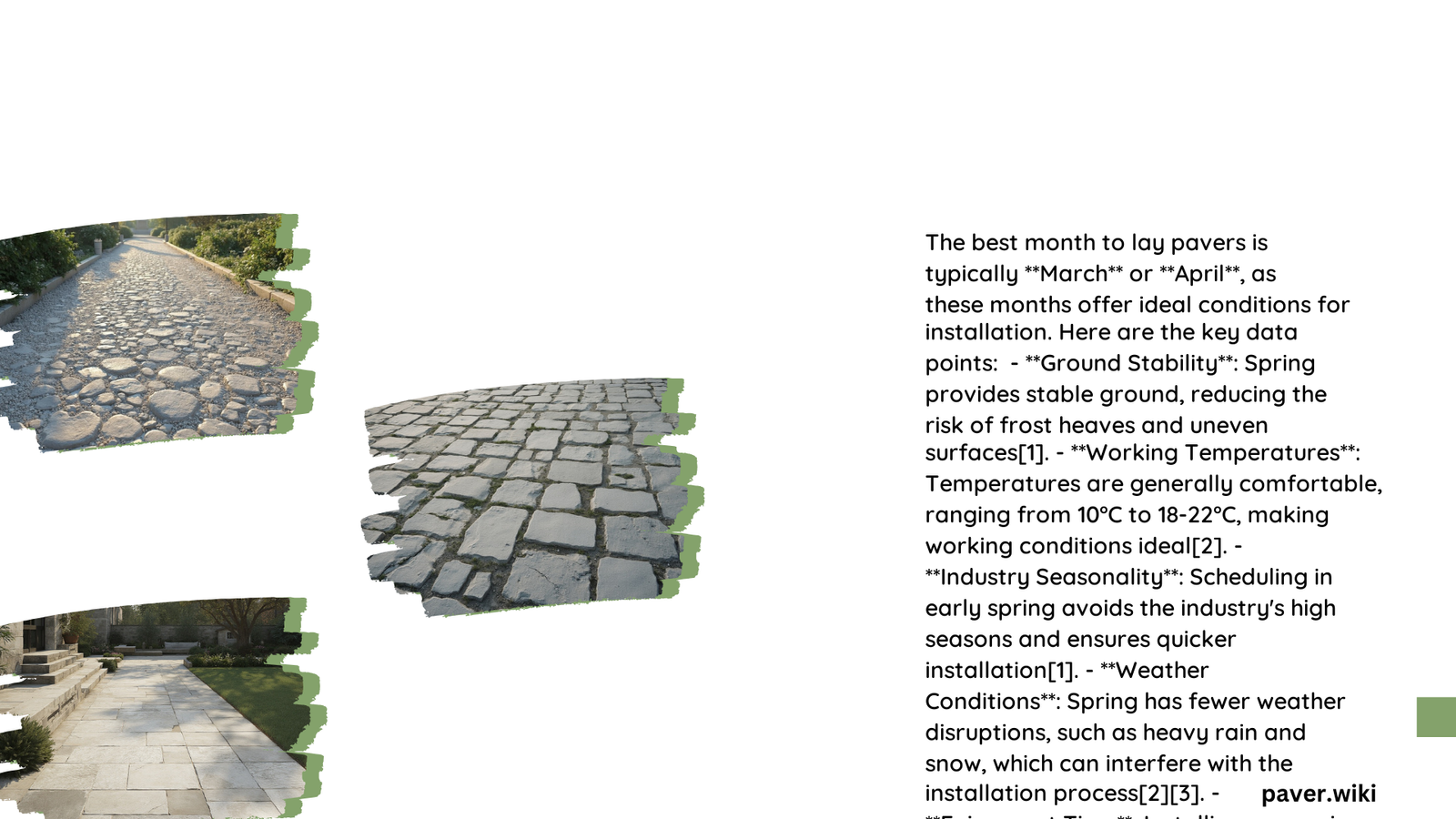Choosing the right month to lay pavers is crucial for a successful installation. The optimal time depends on various factors, including temperature, ground conditions, and seasonal considerations. Generally, early spring and fall are considered the best seasons for paver installation due to moderate temperatures and stable ground conditions. This guide will explore the ideal months and conditions for laying pavers, helping you make an informed decision for your project.
What Are the Best Months for Laying Pavers?
The best months for laying pavers are typically in early spring (March to May) and fall (September to November). These seasons offer several advantages:
- Moderate temperatures
- Stable ground conditions
- Comfortable working conditions
- Optimal curing environment
Let’s explore each season in detail:
Spring Installation
- Ideal months: March to May
- Benefits:
- Ground has thawed from winter frost
- Comfortable working temperatures
- Allows for immediate use throughout summer
- Considerations:
- Avoid installation during heavy spring rains
- Ensure ground is stable and free from frost heaves
Fall Installation
- Ideal months: September to November
- Benefits:
- Moderate temperatures
- Less busy season for contractors
- Potential cost savings due to off-season discounts
- Considerations:
- Complete installation before harsh winter conditions set in
- Be cautious of early frosts
What Weather Conditions Are Ideal for Laying Pavers?

Optimal weather conditions play a crucial role in successful paver installation. Here are the key factors to consider:
- Temperature Range
- Ideal: 40°F (4°C) to 80°F (27°C)
-
Avoid: Below freezing or extreme heat
-
Humidity Levels
- Ideal: Moderate humidity
-
Avoid: High humidity (slows curing) or very low humidity (causes rapid drying)
-
Precipitation
- Ideal: Dry conditions
- Avoid: Heavy rain or saturated ground
How Does Temperature Affect Paver Installation?
Temperature plays a significant role in the paver installation process:
| Temperature Range | Effect on Installation |
|---|---|
| Below 40°F (4°C) | Risk of material freezing, potential damage |
| 40°F – 80°F (4°C – 27°C) | Ideal for installation and curing |
| Above 80°F (27°C) | Can make work uncomfortable, may require more breaks |
What Are the Challenges of Installing Pavers in Different Seasons?
Each season presents unique challenges for paver installation:
Spring Challenges
- Ground may be muddy from spring rains
- Potential for frost heaves in early spring
Summer Challenges
- Extreme heat can make work uncomfortable
- Rapid drying of materials in hot conditions
Fall Challenges
- Early frosts can affect installation
- Limited time before winter sets in
Winter Challenges
- Freezing temperatures can damage materials
- Difficult working conditions
- Ground may be frozen or unstable
How Can I Prepare for Paver Installation in Different Months?
Proper preparation is key to successful paver installation, regardless of the month:
- Spring Preparation
- Ensure ground is thawed and stable
- Plan for potential rain delays
-
Prepare proper drainage
-
Summer Preparation
- Schedule work during cooler hours
- Ensure adequate hydration for workers
-
Protect materials from extreme heat
-
Fall Preparation
- Monitor weather forecasts for early frosts
- Plan to complete work before winter
-
Ensure proper curing time before cold weather
-
Winter Preparation
- Avoid installation if possible
- If necessary, use heated enclosures
- Ensure materials are protected from freezing
What Are the Cost Implications of Laying Pavers in Different Months?
The cost of laying pavers can vary depending on the month:
- Spring and Summer: Generally higher prices due to peak demand
- Fall and Winter: Potential for cost savings due to:
- Off-season discounts
- Lower material prices
- Greater contractor availability
How Long Does Paver Installation Take in Different Months?
Installation time can vary based on the month and project size:
- Small projects (e.g., 100 sq ft patio):
- Spring/Fall: 2-3 days
- Summer: 1-2 days (weather permitting)
-
Winter: Not recommended or significantly longer
-
Large projects (e.g., driveway or large patio):
- Spring/Fall: 1-2 weeks
- Summer: 1-3 weeks (depending on heat)
- Winter: Not recommended or significantly longer
What Are the Key Factors to Consider When Choosing a Month to Lay Pavers?
When deciding on the best month to lay pavers, consider these factors:
- Local climate and weather patterns
- Project size and complexity
- Contractor availability
- Budget constraints
- Desired completion timeline
- Potential for weather-related delays
By carefully considering these factors and the information provided in this guide, you can choose the optimal month for your paver installation project, ensuring a successful and long-lasting result.
References:
1. Pyramid Contracting: When Is The Best Time to Install New Pavers?
2. N&M Restoration: Installing Brick Pavers in Fall: Costs, Maintenance, and More
3. ProScape Services: Is fall a good time to install a paver patio?
